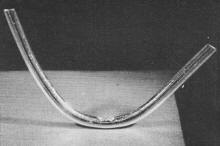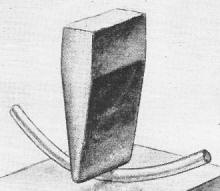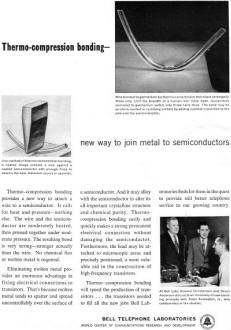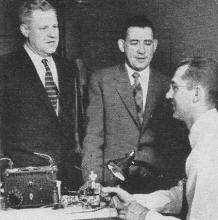


RF Cascade Workbook for Excel
RF & Electronics Symbols for Visio
RF & Electronics Symbols for Office
RF & Electronics Stencils for Visio
RF Workbench
T-Shirts, Mugs, Cups, Ball Caps, Mouse Pads
Espresso Engineering Workbook™
Smith Chart™ for Excel
|
 |
Bell Telephone Laboratories - Thermocompression Wire Bonding
March 1958 Radio News |
|
Bell Labs' first positive gain
semiconductor amplifier was of the
point contact type where the n−type germanium base contact was conductively
bonded to a metallic plate and the emitter and collector connections were made by
point contact "cat whiskers." Such a contact is not mechanically robust and would
not be a long term solution to semiconductor manufacturing. This full-page advertisement
appearing in a 1958 issue of Radio & TV News magazine touts Bell Labs'
development of a
thermocompression
wire bonding process whereby the combination of heat and concentrated pressure causes
an atomic-level reaction between the semiconductor material and a gold interconnect
wire. It proved to be very effective and reliable and paved the way for greater
circuit density and packaging diversity (plastic and ceramic encapsulation vs. metal
cans). Thermosonic
wire bonding eventually replaced thermocompression wire bonding as the dominant
process used in the semiconductor industry due to its lower stress on the semiconductor
substrate and requiring less lateral separation on the die surface (pad pitch).
A 1953 ad told of Bell Labs' development of
wire-wrapping.
Bell Telephone Laboratories Ad

Wire bonded to germanium by thermo-compression technique (enlarged).
Wires only 1/10 the breadth of a human hair have been successfully anchored to germanium
wafers only three hairs thick. The bond may be an ohmic contact or rectifying contact
by adding suitable impurities to the wire and the semiconductor.

One method of thermo-compression bonding. A heated wedge presses
a wire against a heated semiconductor with enough force to deform the wire. Adhesion
occurs in seconds.
 Thermo-compression bonding - Thermo-compression bonding -
new way to join metal to semiconductors
Thermo-compression bonding provides a new way to attach a wire to a semiconductor.
It calls for heat and pressure - nothing else. The wire and the semiconductor are
moderately heated, then pressed together under moderate pressure. The resulting
bond is very strong - stronger actually than the wire. No chemical flux or molten
metal is required.
Eliminating molten metal provides an enormous advantage in fixing electrical
connections to transistors. That's because molten metal tends to spatter and spread
uncontrollably over the surface of a semiconductor. And it may alloy with the semiconductor
to alter its all-important crystalline structure and chemical purity. Thermo-compression
bonding easily and quickly makes a strong permanent electrical connection without
damaging the semiconductor. Furthermore, the lead may be attached to microscopic
areas and precisely positioned, a most valuable aid in the construction of high-frequency
transistors.

At Bell Labs Howard Christensen and Orson Anderson discuss their
discovery of new bonding principle with Peter Andreatch, Jr., who collaborated in
the studies.
Thermo-compression bonding will speed the production of transistors ... the transistors
needed to fill all the new jobs Bell Laboratories finds for them in the quest to
provide still better telephone service to our growing country.
Bell Telephone Laboratories
World Center of Communications Research and Development
Posted January 9, 2020
| Bell Telephone
Laboratories Infomercials |
-
The Future Holds Great Promise
- August 1949 Popular Science
-
Waveguide: 7/47 Popular Mechanics
-
Wire Wrapping - 10/1953 Popular Science
-
X-Rays, 4/60 Radio-electronics
- The Battle of
the Atoms, 4/1948 Radio News
-
The Transistor, 6/1952 Radio-Electronics
- 90-Mile Laboratory
for Telephone and Television, 6/1945 Radio News
-
Wire-Wrap, 10/53 Radio-Electronics
-
EDT Crystals, 10/47 Radio-Craft
- Germanium Refining,
5/54 Radio & TV News
- Crystal Timekeeping,
1/46 Radio News
- Transatlantic
Cable, 11/56 Radio & Television News
- Pipe Circuits,
11/48 Radio & Television News
-
Coaxial
Electron Tube, 6/54 Radio & Television News
- Thermocompression
Wire Bonding, 3/58 Radio News
-
Radio Relay Stations, 8/52 Radio & Television News
- Isolators,
6/56 Radio & Television News
- Punch
Cards, 3/55 Radio & Television News
-
Over-the-Horizon
Communications, 10/55 Radio & Television News
- Memory
Devices, 2/58 Radio & TV News
-
Adventure in Silicon, 5/55 Radio & Television News
- Pipes of Progress,
6/55 Radio & Television News
-
Project Echo, 11/60 Electronics World
|
-
Testing Phones - November 1947 Popular Science
-
Jacques Bernoulli, February 1960 Radio-Electronics
-
Type-O Carrier System, October 1952 Radio-Electronics
-
Electron Microscope, 4/1952 Radio-Electronics
-
Thermistor, 11/1946 Radio-Craft
-
Germanium Crystal, 1/1954 Radio-Electronics
-
Lens
Antenna, 5/46 Radio-Craft
- Quality Control, 6/46
Radio News Article
- Transcontinental
Radio-Relay, 10/51 Radio & TV News
- Solar
Battery, 7/54 Radio & Television News
-
Germanium Transistors, 1/54 Radio & Television News
- Cavity
Magnetron, 10/45 Radio News
-
The Cableman, 10/49 Radio & Television News
-
Coaxial Cable, 12/49 Radio & Television News
-
Tin
Whiskers, 12/55 Radio & Television News
- Relay
Contact Inspection, 7/55 Radio & Television News
- Transistor's
10th Anniversary, 6/58 Radio & Television News
-
Wire
Wrapping, 10/53 Radio & Television News
- Junction
Diode Amplifier, 11/58 Radio News
-
Nobel Prize Winners, 2/57 Radio & Television News
-
Diode Speeds Voices, 8/58 Popular Electronics
-
Microwave Relays, 7/59 Electronics World
|
|

|

Copyright: 1996 - 2024
Webmaster:
Kirt
Blattenberger,
BSEE - KB3UON
RF Cafe began life in 1996 as "RF Tools" in an AOL screen name web space totaling
2 MB. Its primary purpose was to provide me with ready access to commonly needed
formulas and reference material while performing my work as an RF system and circuit
design engineer. The World Wide Web (Internet) was largely an unknown entity at
the time and bandwidth was a scarce commodity. Dial-up modems blazed along at 14.4 kbps
while tying up your telephone line, and a nice lady's voice announced "You've Got
Mail" when a new message arrived...
|
All trademarks, copyrights, patents, and other rights of ownership to images
and text used on the RF Cafe website are hereby acknowledged.
|
|
All trademarks, copyrights, patents, and other rights of ownership to images
and text used on the RF Cafe website are hereby acknowledged.
My Hobby Website: AirplanesAndRockets.com
My Daughter's Website: EquineKingdom
|
|
|


 |














